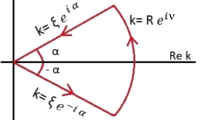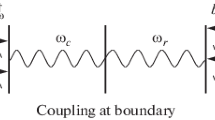Abstract
We consider a simple (1+1)-dimensional model for the Casimir–Polder interaction consisting of two oscillators coupled to a scalar field. We include dissipation in a first-principles approach by allowing the oscillators to interact with heat baths. For this system, we derive an expression for the free energy in terms of real frequencies. From this representation, we derive the Matsubara representation for the case with dissipation. We consider the case of vanishing intrinsic frequencies of the oscillators and show that the contribution from the zeroth Matsubara frequency is modified in this case and no problem with the laws of thermodynamics appears.
Similar content being viewed by others
References
V. B. Bezerra, G. L. Klimchitskaya, and V. M. Mostepanenko, “Thermodynamical aspects of the Casimir force between real metals at nonzero temperature,” Phys. Rev. A, 65, 052113 (2002).
G. L. Klimchitskaya and V. M. Mostepanenko, “Conductivity of dielectric and thermal atom-wall interaction,” J. Phys. A: Math. Theor., 41, 312002 (2008).
G. L. Klimchitskaya and V. M. Mostepanenko, “Casimir free energy and pressure for magnetic metal films,” Phys. Rev. B, 94, 045404 (2016).
J. Schwinger, L. L. DeRaad, Jr. and K. A. Milton, “Casimir effect in dielectrics,” Ann. Phys., 115, 1–23 (1978).
D. Kupiszewska, “Casimir effect in absorbing media,” Phys. Rev. A, 46, 2286–2294 (1992).
F. S. S. Rosa, D. A. R. Dalvit, and P. W. Milonni, “Electromagnetic energy, absorption, and Casimir forces: Uniform dielectric media in thermal equilibrium,” Phys. Rev. A, 81, 033812 (2010).
F. S. S. Rosa, D. A. R. Dalvit, and P. W. Milonni, “Electromagnetic energy, absorption, and Casimir forces: II. Inhomogeneous dielectric media,” Phys. Rev. A, 84, 053813 (2011).
F. C. Lombardo, F. D. Mazzitelli, and A. E. Rubio López, “Casimir force for absorbing media in an open quantum system framework: Scalar model,” Phys. Rev. A, 84, 052517 (2011).
P. R. Berman, G. W. Ford, and P. W. Milonni, “Nonperturbative calculation of the London–van der Waals interaction potential,” Phys. Rev. A, 89, 022127 (2014).
M. A. Braun, “The Casimir energy in a dispersive and absorptive medium in the Fano diagonalization approach,” Theor. Math. Phys., 190, 237–250 (2017).
H. -P. Breuer and F. Petruccione, The Theory of Open Quantum Systems, Oxford Univ. Press, New York (2002).
M. Bordag, “Drude model and Lifshitz formula,” Eur. Phys. J. C, 71, 1788 (2011).
F. Intravaia and R. Behunin, “Casimir effect as a sum over modes in dissipative systems,” Phys. Rev. A, 86 (2012).
U. Fano, “Effects of configuration interaction on intensities and phase shifts,” Phys. Rev., 124, 1866–1878 (1961).
B. Huttner and S. M. Barnett, “Quantization of the electromagnetic field in dielectrics,” Phys. Rev. A, 46, 4306–4322 (1992).
H. B. Callen and T. A. Welton, “Irreversibility and generalized noise,” Phys. Rev., 83, 34–40 (1951).
G. W. Ford, J. T. Lewis, and R. F. O’Connell, “Quantum Langevin equation,” Phys. Rev. A, 37, 4419–4428 (1988).
G. W. Ford, J. T. Lewis, and R. F. O’Connell, “Quantum oscillator in a blackbody radiation field,” Phys. Rev. Lett., 55, 2273–2276 (1985).
M. Bordag, “Vacuum energy in smooth background fields,” J. Phys. A: Math. Gen., 28, 755–765 (1995).
M. J. Renne, “Retarded Van der Waals interaction in a system of harmonic oscillators,” Phys., 53, 193–209 (1971).
M. J. Renne and B. R. A. Nijboer, “Microscopic derivation of macroscopic Van der Waals forces,” Chem. Phys. Lett., 1, 317–320 (1967).
M. Bordag and J. M. Mu˜noz-Casta˜neda, “Dirac lattices, zero-range potentials, and self-adjoint extension,” Phys. Rev. D, 91, 065027 (2015).
Author information
Authors and Affiliations
Corresponding author
Additional information
Prepared from an English manuscript submitted by the author; for the Russian version, see Teoreticheskaya i Matematicheskaya Fizika, Vol. 195, No. 3, pp. 391–421, June, 2018.
Rights and permissions
About this article
Cite this article
Bordag, M. Vacuum and Thermal Energies for Two Oscillators Interacting Through A Field. Theor Math Phys 195, 834–860 (2018). https://doi.org/10.1134/S0040577918060041
Received:
Revised:
Published:
Issue Date:
DOI: https://doi.org/10.1134/S0040577918060041




